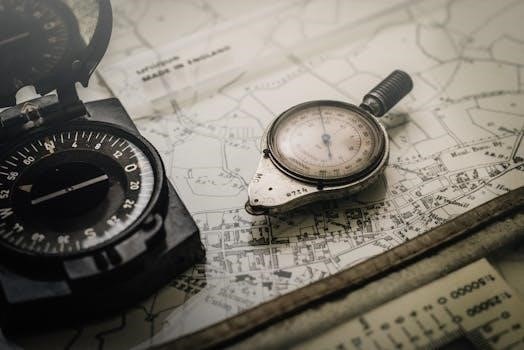Distance and Displacement⁚ Worksheet with Answers PDF
Looking for a comprehensive resource to master distance and displacement concepts? Our worksheet with answers in PDF format offers practice problems, real-world examples, and step-by-step solutions. Perfect for students learning about motion and vectors, it enhances problem-solving skills. Download now and excel!
Understanding Distance and Displacement
Distance and displacement are fundamental concepts in physics that describe the motion of objects. Understanding the difference between them is crucial for solving problems related to kinematics and dynamics. Distance is a scalar quantity representing the total length of the path traveled by an object, regardless of direction. It’s the accumulation of all movements, forward, backward, or any other direction.
Displacement, on the other hand, is a vector quantity that refers to the shortest distance between an object’s initial and final positions, along with the direction. It represents the straight-line change in position. For example, if someone walks 3 km north and then 4 km east, the distance traveled is 7 km, but the displacement is the straight-line distance from the starting point to the ending point, with a specific direction (northeast).
Distinguishing these concepts is key to accurately analyzing motion. Distance accounts for the entire journey, while displacement focuses solely on the net change in location. This difference becomes particularly important when dealing with complex movements involving changes in direction. Mastering this distinction paves the way for understanding more advanced concepts like velocity and acceleration.
Key Differences Explained
The core distinction between distance and displacement lies in their nature as scalar versus vector quantities. Distance, being a scalar, only considers magnitude, representing the total path length covered during motion. Imagine a car driving around a circular track; the distance it travels is the entire circumference of the track. However, displacement, being a vector, accounts for both magnitude and direction. If the car completes a full lap, its displacement is zero because it ends up back where it started, irrespective of the distance covered.
Another key difference arises in how they are calculated. Distance is simply the sum of all path segments, regardless of their direction. Displacement, however, requires considering the direction of movement. It’s calculated as the final position minus the initial position, often involving vector addition or subtraction to account for directional changes. This means that displacement can be positive, negative, or zero, depending on the direction of movement relative to the chosen coordinate system.
In essence, distance tells you “how much ground an object has covered” during its motion, while displacement tells you “how far out of place an object is” from its starting point. Recognizing this fundamental difference is crucial for correctly interpreting and solving physics problems involving motion.
Calculating Distance⁚ Total Path Length
Calculating distance involves determining the complete length of the path an object travels, irrespective of direction. It is a scalar quantity, meaning only the magnitude matters. To find the distance, simply add up the lengths of each segment of the journey. For instance, if someone walks 5 meters east, then 3 meters north, the total distance traveled is 8 meters.

When the path is not a straight line, you must consider each distinct segment. If a runner completes a lap around a 400-meter track, the distance they’ve run is 400 meters, regardless of their final position. Distance is always a positive value or zero if there is no movement.

In practical scenarios, calculating distance might involve using measuring tools like rulers or odometers. For more complex paths, you might need to break down the journey into smaller, measurable segments. Remember, the key is to sum up all the individual lengths to obtain the total path length. This straightforward approach makes calculating distance relatively simple, focusing solely on the accumulated length of the journey.
Calculating Displacement⁚ Straight-Line Change in Position

Calculating displacement focuses on the straight-line distance between an object’s initial and final positions, including direction. It is a vector quantity, meaning both magnitude and direction are essential. Unlike distance, displacement can be zero even if an object has moved, such as when returning to its starting point.
To calculate displacement, determine the final position relative to the initial position. This often involves using vector addition, particularly if the motion occurs in multiple directions. For example, if someone walks 3 km north and then 4 km east, the displacement is the hypotenuse of a right triangle with sides of 3 km and 4 km, which can be found using the Pythagorean theorem.
The direction is specified relative to the starting point, such as northeast in the previous example. If an object moves along a circular path and returns to its starting point, the displacement is zero, regardless of the distance traveled. Therefore, understanding the starting and ending points is crucial for accurate displacement calculations. Displacement provides a concise measure of net change in position.
Distance and Displacement⁚ Example Problems
To solidify understanding of distance and displacement, let’s explore some example problems. These scenarios illustrate the key differences and calculation methods for each concept.
Example 1⁚ A person walks 5 meters east, then 3 meters south. What is the distance traveled, and what is the displacement?
Solution⁚ The distance is the total path length, which is 5 meters + 3 meters = 8 meters. The displacement is the straight-line distance from the starting point to the ending point. Using the Pythagorean theorem, the displacement is √(5² + 3²) = √34 ≈ 5.83 meters. The direction can be described as southeast.
Example 2⁚ A car drives 10 km north and then turns around and drives 4 km south. What is the distance traveled, and what is the displacement?
Solution⁚ The distance is 10 km + 4 km = 14 km. The displacement is 10 km ⏤ 4 km = 6 km north.
These examples demonstrate how distance accounts for the entire path, while displacement considers only the net change in position. Further problems will explore more complex scenarios.
Problem 1⁚ Multi-Directional Movement
Consider a scenario where an object undergoes movement in multiple directions. This type of problem helps illustrate the difference between distance and displacement more clearly. Imagine a hiker navigating a trail with varying directions.
Problem⁚ A hiker starts at their campsite and walks 4 kilometers north. They then turn and walk 3 kilometers east, followed by 2 kilometers south, and finally, 1 kilometer west. Determine the total distance the hiker traveled and their overall displacement from the campsite.
Solution Approach⁚
Distance⁚ The distance is the sum of all the individual path lengths. Add up each segment of the hike⁚ 4 km + 3 km + 2 km + 1 km = 10 km. The hiker traveled a total of 10 kilometers.
Displacement⁚ To find displacement, consider north/south and east/west components separately. Net north displacement⁚ 4 km ⏤ 2 km = 2 km. Net east displacement⁚ 3 km ⏤ 1 km = 2 km. The overall displacement is the resultant vector. Use Pythagorean theorem⁚ √(2² + 2²) = √8 ≈ 2.83 km. The direction is northeast.
Problem 2⁚ Round Trip Scenarios
Round trip scenarios are excellent for highlighting the contrast between distance and displacement. These problems often involve an object returning to its starting point, making them conceptually significant.
Problem⁚ A delivery driver leaves the warehouse and drives 15 kilometers east to deliver a package. After the delivery, the driver returns directly to the warehouse, traveling 15 kilometers west. Calculate the total distance traveled by the delivery driver and their displacement.
Solution Approach⁚
Distance⁚ The distance is the total length of the path covered by the driver. In this case, the driver travels 15 km east and then 15 km west. Therefore, the total distance is 15 km + 15 km = 30 km.
Displacement⁚ Displacement is the change in position from the starting point to the ending point. Since the driver returns to the warehouse, their final position is the same as their initial position. Hence, the displacement is 0 km. This is because there is no net change in the driver’s location relative to the starting point.
Worksheet Applications⁚ Real-World Examples
Understanding distance and displacement is crucial in various real-world scenarios. Our worksheet provides examples that connect these concepts to everyday experiences, enhancing comprehension and practical application.
Navigation and Travel⁚ Consider a GPS navigation system. While it calculates the shortest path (displacement) to your destination, the actual route you take involves turns and varying distances. The odometer in your car measures the total distance traveled, while displacement would be the straight-line distance from your starting point to where you are.
Sports⁚ In sports like track and field, athletes often run around a track. The distance they cover is the total length of the track, while their displacement after completing a lap is zero because they return to their starting point. Similarly, in a soccer game, players run significant distances, but their overall displacement during parts of the game may be small if they stay within a limited area.
Robotics and Automation⁚ Engineers designing robots need to consider both distance and displacement. For a robot tasked with moving objects within a warehouse, understanding the total distance it must travel helps optimize battery life, while displacement ensures it reaches the correct location.
Using Maps and Directions
Maps and directions provide a practical way to understand distance and displacement. When planning a route, maps display various paths, each with a specific distance. However, the shortest distance “as the crow flies” represents the displacement, a straight-line measure from start to finish.

Map Reading⁚ Consider using a map to navigate a city. The streets you follow represent the total distance traveled, which might involve turns and detours. In contrast, the displacement would be the direct line connecting your origin and destination, often shorter than the actual route.
Directional Instructions⁚ Directions like “walk 1 km east, then 1 km south, and then 1 km east again” offer a clear illustration. The total distance covered is 3 km. However, the displacement can be calculated using the Pythagorean theorem, forming a right triangle. The result is approximately 2.24 km southeast from the starting point.
Real-World Application⁚ Using maps and directions, students can plot paths, calculate distances, and determine displacements. This exercise reinforces their understanding of these concepts and their ability to apply them in real-world scenarios, such as planning a trip or understanding GPS navigation.
Worksheet Solutions⁚ Step-by-Step Guides
Our worksheet provides comprehensive, step-by-step guides for solving distance and displacement problems. These guides break down complex scenarios into manageable steps, ensuring students grasp the underlying principles. Each solution clearly outlines the process, making it easier to understand the difference between distance, the total path length, and displacement, the straight-line change in position.
Detailed Explanations⁚ Every problem includes a detailed explanation of the steps taken to arrive at the solution. This helps students understand the reasoning behind each calculation, rather than simply memorizing formulas. For example, when dealing with multi-directional movement, the guide shows how to add distances traveled in each direction to find the total distance.
Visual Aids⁚ Where appropriate, visual aids such as diagrams and graphs are included to illustrate the problem and its solution. These visuals help students visualize the motion and better understand the relationship between distance and displacement. They are particularly useful when dealing with vectors and direction.
Error Prevention⁚ The step-by-step guides also highlight common mistakes and provide tips for avoiding them. This helps students develop problem-solving skills and build confidence in their ability to tackle similar problems independently. By following these guides, students can reinforce their understanding and improve their accuracy.
Relative Motion and Frames of Reference
Understanding relative motion is crucial when analyzing distance and displacement. Relative motion describes how the motion of an object appears different depending on the observer’s frame of reference. This concept becomes significant when considering multiple moving objects or observers in different locations, affecting how distance and displacement are perceived and calculated.
Defining Frames of Reference⁚ A frame of reference is the perspective from which motion is observed and measured. Different frames of reference can lead to varying descriptions of the same motion. For instance, a person walking inside a moving train has a different displacement relative to the train compared to their displacement relative to the ground.
Impact on Distance⁚ The distance traveled by an object remains constant regardless of the frame of reference. However, the perceived path and direction can vary. Consider two cars moving in the same direction; their relative speed and the distance between them depend on which car serves as the frame of reference.
Displacement and Observation⁚ Displacement is significantly affected by the frame of reference. The displacement of an object is the change in its position vector, which depends on the observer’s location and motion. Thus, understanding the frame of reference is essential for accurately determining displacement in complex scenarios involving relative motion.
Advanced Concepts⁚ Vectors and Direction
Delving deeper into distance and displacement requires a robust understanding of vectors and direction. Vectors are mathematical entities possessing both magnitude and direction, making them essential for accurately representing displacement, unlike distance which is a scalar quantity, representing only magnitude. Incorporating vector principles allows for a more precise analysis of motion in various dimensions.
Vector Representation of Displacement⁚ Displacement is fundamentally a vector, indicating the straight-line change in position from the initial point to the final point. This vector includes both the magnitude (shortest distance) and the direction. For example, a displacement of “5 meters east” provides more information than simply stating “5 meters.”
Vector Addition and Subtraction⁚ When dealing with multiple displacements, vector addition is crucial. If an object undergoes two displacements, the resultant displacement is the vector sum of the individual displacements. Vector addition accounts for both magnitude and direction, often requiring trigonometric methods or component-wise addition. Vector subtraction is similarly important when analyzing relative motion or changes in displacement.
Directional Components⁚ Direction is a critical attribute of displacement vectors. Common methods for specifying direction include using compass directions (north, south, east, west), angles relative to a reference axis, or component notation (e.g., x and y components in a two-dimensional plane). Accurately representing and manipulating these directional components is essential for solving complex displacement problems.